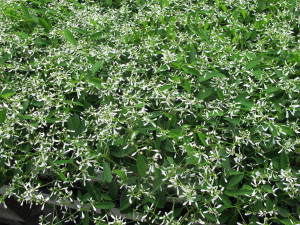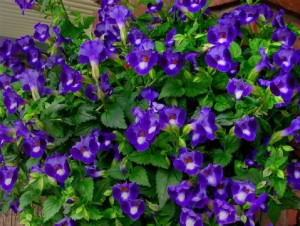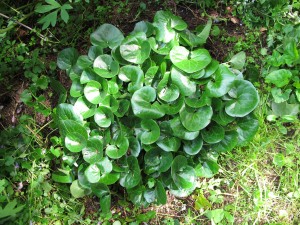Annual Flowers: A Great Gift for Mom!
Okay, Mom’s Day is coming right up, and you haven’t bought her anything. Instead of getting another electric waffle iron or promising to wash her car, just like you did last year (but haven’t done yet), head to your local family-owned garden center. There are plenty of these, and they are ready and waiting for you. The flowers you get there will be perfect for this climate, and tried and tested by the owners and staff.
Here is what I am suggesting: make a nice planter full of annual flowers that will bloom all summer. Mom will think of you every time she waters it. But before you buy things, think about the sun conditions where she will place it. If it will go on a north-facing deck, you need flowers whose tags include the words “shade” or “part shade.” A few annuals are even labeled “sun to shade,” but they are rare. If the plant is going in full sun, or all afternoon sun, look for tags that say “sun.”
If you are buying a pot to place your gift in, consider these factors: old fashioned clay pots are nice, but they lose water through the pores, allowing the roots to dry out faster than a nice glazed ceramic pot would, or (for those on a strict budget) a plastic or fiberglass pot. If Mom is busy, and I’ve never met one who isn’t, you should probably avoid the clay pots.
When it comes to pots, bigger is better. More room for soil and for plants that want to expand. More potting mix to hold moisture. Don’t think the flowering plant you buy will stay that size. It will grow. Six cubic inches of potting soil per plant is the rule of thumb, though often I don’t follow that – and squeeze in more plants.
Self-watering planters are good, too. These pots have a water reservoir in the base, below a shelf, and a wicking system that keeps roots moist, but not soggy. Fill that reservoir once a week and the soil stays adequately moist in most situations. They cost more, but hey, Mom was good to you. (Remember all those rhubarb pies she made when you were growing up?).
What should you put in the pot? Certainly not ordinary dirt (or soil as we are supposed to say). I use a 50-50 mix of potting soil and compost, my own or purchased. Moo-Doo brand composted cow manure works great, but there are plenty of kinds. If you have a 16-inch diameter pot (a nice size) you can also mix into the soil ingredients a half-cup of slow release organic fertilizer, or less for smaller pots.
The basic design principal for planters is this: if you have a big planter (16- to 24-inches across) put something tall in the middle, surrounded by 3-complimenatry-colored medium sized plants, and then squeeze in some “trailers” that will hang over the edges. The trailers may be just foliage plants, or blooming plants. A 10- to 12-inch planter can have a tall or medium height plant, and some trailers. Or you can buy three or more 6- to 8-inch pots and put just one plant in each, and then arrange the pots in a nice trio.
Now the plants. There are plenty of nice ones, from old fashioned petunias (Mom, may she rest in peace, usually got these from me on Mother’s Day when I was a boy), to new things that are trademarked hybrids. Almost all will bloom all summer, though some like Osteospurmum look great in spring and fall, but are just foliage in the heat of summer. I visited my favorite garden center recently, and got lots of the ideas for planters.
Let’s start with the shade. Impatiens was the favorite for decades, then a few years ago, along came a blight that ruined them. In pots on a deck, with fresh soil, you will probably do just fine. They are a medium-sized plant that never stops blooming till frost, and come in a variety of colors, and with both single and double blossoms. I am still leery of planting them in the ground, especially if the blight ever struck there in the past.
Other shade plants? Torenia is being promoted to replace Impatiens. It is nice, but not as dramatic (for me, anyhow). New Guinea Impatiens is also good, but is rarely sold in those inexpensive 6-packs. Begonias can be great; I saw a black-leafed one with white blossoms that I liked called ‘Mocca White”. Oxalis is a favorite of mine and I bring it inside each fall and winter it over as a houseplant.
For sun there are even more plants to choose from. I like Superbenas, which are trademarked, hybridized verbenas, and Supertunias (the same, but derived from petunias). ‘Diamond Frost’ is a Euphorbia hybrid that has huge numbers of tiny white blossoms all summer. Angelonia has a 20-inch stalk with lots of pink blossoms. Salvias are great plants, with plenty of sizes, heights and colors. Licorice plant (Helichrysum) is a great foliage plants that takes hot, sunny locations. It comes in gray and chartreuse-leafed varieties. Persian shield has shiny purple leaves for hot, dry places.
Don’t take my advice when it comes to plants: ask those friendly folks at your garden center. They deal with them all day, every day, and probably take injured plants home, free. So get Mom something nice, she’ll love you for it – even if the colors clash.
Henry is the author of 4 gardening books (also good Mothers Day presents). His web site is www.Gardening-Guy.com.
Shade Annuals
Last fall a reader alerted me to the fungal disease that has devastated that wonderful shade annual, impatiens, throughout much of New England. The disease, called impatiens downy mildew, will be a problem again for most gardeners this year. Any garden that had the disease last year will have it again this year – even our coldest winters will not cleanse the soil of it. I wish I had known about it sooner, as prompt removal of affected plants may stop the spread of the disease. So if you did not have the disease last year, watch your plants carefully this year and bag and dispose of any diseased plants promptly.
Impatiens downy mildew symptoms are these: yellowing of leaves, then a limp appearance, as if it needs to be watered. Next comes a downy white fungal growth on the undersides of leaves. Then leaves and flowers drop, leaving just a stem with a few leaves on top – as if slugs had eaten the leaves. I have read that if you don’t plant impatiens in a site that has had the disease for a year or two, the soil may become free of disease. But I wouldn’t count on it.
There are two related plants that will thrive in shade or part shade and that are not susceptible to the mildew: New Guinea impatiens and SunPatiens, which is a trademarked hybrid. SunPatiens is advertised as good for part sun to sun – but not deep shade. But it is being marketed as a replacement of impatiens. I wonder if it will be able to bloom as vigorously as our old favorite in full shade. Both are generally sold in individual pots for around $5, quite an upgrade from a six-pack for $3.50 or so that I was accustomed to paying for impatiens in past years.
Another plant that is being touted as a replacement for impatiens is Torenia. I spoke to two landscapers who have used Torenia in past years and say that it is nice enough, but it will not satisfy impatiens-lovers. I’ve heard that it does not have as many blossoms per plant, generally, and is often available in just a few colors – shades of blue and purple, and in white. However, I have found it for sale in multi-packs in a few places and did find one nursery with 4-packs that listed rose, magenta, lemon drops and white as colors available.
I have used bedding lobelia as a nice shade annual, though in my experience it wants a little sun or filtered sun. I love the intense blue that it often displays, though it is available in other colors, too. I started seeds indoors back on April 17, a mix called ‘Cascade of Color’ that promised blue, blue with a white eye, lilac, red, ruby and white.
Right now my lobelia seedlings are only 2 inches tall but I assume they will take right off when I separate them and get them in the ground. The only problem with a mix like that is that one cannot determine what color any given seedling will be – unless you wait for them to bloom in the pot. And, when I read the seed packet (from Botanical Interests) just now, I see that this variety is advertised for full sun. I have plenty, so I’ll try some in shade, too.
So what else can we do to provide color in shade? Try some perennials. Granted, most only bloom for 1 to 3 weeks, but if you select plants with good foliage they can be a joy all summer. I love European wild ginger (Asarum europaeum) for its very glossy dark green leaves. It forms a nice expanding clump, even in dry shade with competition from tree roots. The blossoms are hidden beneath the foliage, but it doesn’t matter to me. This is a great shade plant. I plant them in clumps of three about 18 inches from center to center.
Then there is bigroot geranium (Geranium macrorhizum). Not to be confused with your mom’s red geraniums (which are technically not geraniums at all), this is a nice spreading plant that thrives in full shade and blooms with pink, magenta or white flowers in late May or early June. The leaves look good all summer, each plant a spreading mound 12 to 18 inches tall and 15 inches wide. I use it as a groundcover. I have read that it will do well in sun, too, and that it tolerates a wide range of soil and pH conditions. If it wanders too far? It pulls easily, and you can give the roots to someone who doesn’t have it.
I have never tried either the geranium or the ginger in a pot, but will this year and grow them on my north-facing, shady deck. I’ll give them a 50-50 mix of standard potting soil and compost, and I bet they look just fine.
It seems that every year there is a new bug or a new disease that threatens some plant in our garden. I guess we will have to keep on adapting and changing – just like the pests do. Good luck!
Henry Homeyer is the author of 4 gardening books and a children’s fantasy-adventure called Wobar and the Quest for the Magic Calumet. You may reach him at PO Box 364, Cornish Flat, NH 03746 or henry.homeyer@comcast.net.\







